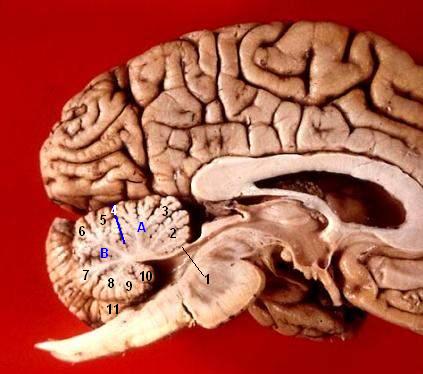Archivo: Human brain midsagittal view description
Descripción: Human brain - midsagittal view - cerebellum Velum medullare superius, Lingula cerebelli Lobulus centralis Culmen Fissura prima Declive Folium vermis Tuber vermis Pyramis vermis Uvula vermis Nodulus Tonsilla cerebelliA: Lobus cerebelli anterior, B: Lobus cerebelli posterior, 10: Lobulus flocculonodularis The anterior– posterior divisions (Lobes) are best seen in a midsagittal cut through the vermis. The Anterior Lobe Occupies the vermis and hemispheres rostral to the Primary Fissure. The Posterior Lobe makes up the bulk of the cerebellum, comprising the remaining vermis and hemispheres from the Primary Fissure to the Posterolateral Fissure. The latter fissure separates the Posterior lobe from the Flocculonodular Lobe. The Flocculonodular Lobe (Archicerebellum) is the oldest part of the cerebellum and connects with the vestibular system to coordinate balance and equilibrium. The Anterior Lobe (Paleocerebellum) is associated with the development and coordination of the limbs. The Posterior Lobe (Neocerebellum) developed in association with the development of the cerebral cortex and is associated with the coordination of complex skilled movements. (font: arial black, size: 10)
Título: Human brain midsagittal view description
Créditos: http://www.healcentral.org/healapp/showMetadata?metadataId=40566 (Internet Archive of file description page)
Autor(a): John A Beal, PhD Dep't. of Cellular Biology & Anatomy, Louisiana State University Health Sciences Center Shreveport
Permiso: CC-BY
Términos de Uso: Creative Commons Attribution 2.5
Licencia: CC BY 2.5
Enlace de Licencia: https://creativecommons.org/licenses/by/2.5
¿Se exige la atribución?: Sí
Usos del archivo
La siguiente página enlaza a este archivo:


